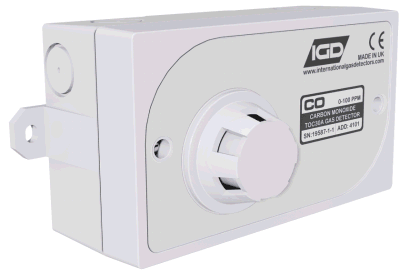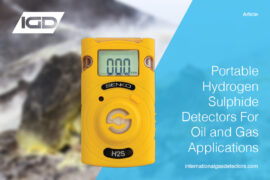Cold room units (or walk-in freezers) are an integral part of the food and beverage processing industries. Typical refrigerant gases include carbon dioxide, ammonia, and hydrocarbons such as propane, isobutane and propylene. Older cold storage solutions still use freon gases such as R134a. Thus, a versatile range of gas detection solutions are required for cold storage applications.
Numerous accidents involving refrigerant gas leaks have been reported worldwide, hospitalizing hundreds, and killing several. Typical causes of refrigerant leak accidents involve system wear or failure of components, lack of preventive maintenance guidelines, and control system failure.
Cold Storage Gases: Ammonia, Carbon Dioxide & More
Ammonia gas is highly toxic and flammable. Its regulated short-term exposure limit is just 35 ppm, which is sufficient to severely damage mucous membranes, lungs, and eyes. Acute inhalation of ammonia can cause dizziness, coughing, and even death. Prolonged chronic exposures to ammonia and hydrocarbons can result in pneumonia, bronchial irritation, and several other irreversible effects.
Carbon Dioxide is quickly becoming the refrigerant choice for newer cold storage solutions due to its low global warming potential. However, carbon dioxide poses a toxic threat to users and can accumulate in confined spaces near ground levels. Moreover, it is odourless and is undetectable by personnel. Therefore, a carbon dioxide gas detection system is required, to ensure toxic exposure levels are not breached. The toxic exposure levels in the UK are 0.5% VOL 8hrs and 1.5%VOL for 15minutes.

Finally, older cold storage refrigeration systems typically use older freon gases. These require low level refrigerant leak detection systems to ensure any leaks are detected as early as possible. This is to ensure that the user is compliant with refrigeration safety codes including ASHRAE 15, EN 378, CSA-B52 and emissions reduction standard F-Gas Regulations.
The commercial cold storages industry is the second-largest consumer of refrigerants. Not only do gas leaks cause hazards to personnel and the environment, but they can also directly affect the energy efficiency of cold storage. Therefore, smart gas detection solutions are imperative to ensure reliable and continuous monitoring of refrigerant gas levels, creating a safe working environment for personnel and making refrigeration units energy efficient and reducing operational costs.
Portfolio of IGD’s Gas Detection Solutions
International Gas Detectors (IGD) offers an extensive portfolio of innovative and cost-effective refrigerant gas detection solutions to ensure workplace safety. We offer both fixed and portable gas detectors.
Portable gas detection solutions
Portable sensors are lightweight and easy to carry. They are particularly useful for personnel unaware of the existing gas detection systems in cold storage facilities and confined spaces where fixed gas detectors are not feasible. IGD offers the following portable gas detectors:
- iGAS personal CO2 monitor: a cost-effective, extremely lightweight, CO2 detector equipped with non-dispersive infrared sensors and lithium-ion battery technology, delivering faster charging and long-lasting battery run-time. It is USB-rechargeable and allows downloading of alarm records for analysis. It is an ideal solution for confined spaces and harsh industrial environments. The iGAS is supplied pre-programmed with set alarm levels. The iGAS sensor last up to 7 years. Available to purchase online from our store.

- Portable Ammonia Gas Detector – SGT-P: ergonomically designed, lightweight detector, with configurable alarms and ability to detect toxic concentration levels within 0-100 ppm. It has an unlimited operational lifetime due to replaceable parts. Available to purchase online from our store.
Fixed gas detection solutions
Fixed gas detectors are ideal for continuous monitoring of refrigerant gas levels. The control panels can be mounted at entrance doors for the personnel to read gas levels before entering cold storage units and prevent entry in the event of an alarm. They are also ideal for hard to access areas, inaccessible by personnel, to detect gases lighter than air that accumulates at ceiling level. IGD offers the following fixed gas detectors:
- Ionic Based Sensors for Ammonia Gas Detection: based on non-consumptive ionic technology, they outperform conventional optical, electrochemical, and infrared-based detectors, and can operate down to -40 degrees C. They are ideal for harsh environments like industrial cold storage.
- TOC-20 Freon Gas Detector: an easy-to-integrate, standalone detector for live readings with flexible applicability (standalone or third-party integrable). Its ability to detect multiple freon gases makes it an ideal choice for many applications.
- TOC-750 Addressable Safe Area : most versatile next-generation sensor based on unique Sentinel+™ communication and a single 2-core cable design. It can detect over 400 gases, offers multiple I/O points per detector, and has a unique labyrinth arrangement that safeguards the sensor against water splashes, corrosive gases and dust.
- TOC-750X Series: most versatile ATEX/IECEx sensors equipped with on-board I/O facility, 750X series detectors utilize advanced Sentinel+™ technology and can detect over 300 toxic and flammable gases. They are available as with- and without-display options and allow non-intrusive calibration.
- TOC-750S Aspirated detector –is the perfect solution for the harsh environments in cold stores or industrial refrigeration applications where access maybe limited. The TOC-750S allows you to draw a sample from the cold store to the detector which is placed in the corridor or service area. In addition, the TOC-750S utilises our Sentinel+ communication technology which provides unique low level leak detection for all gases including freon gases to ensure compliance with F-Gas Regulations.
Contact a member of the IGD team today for RFQs on any of our leading gas detection solutions.




